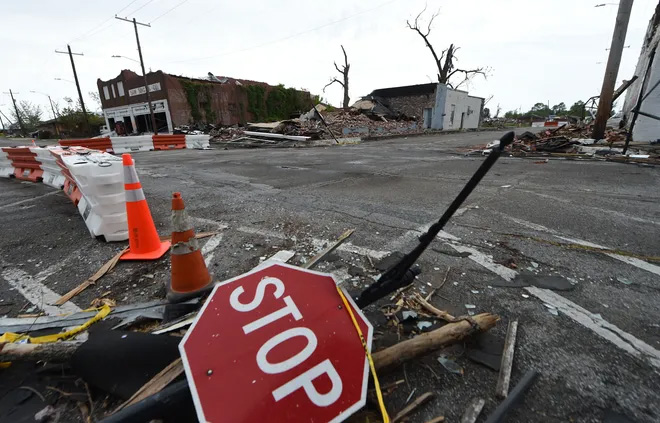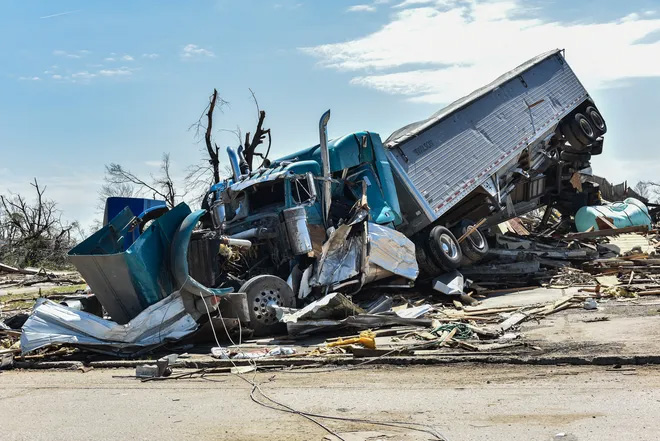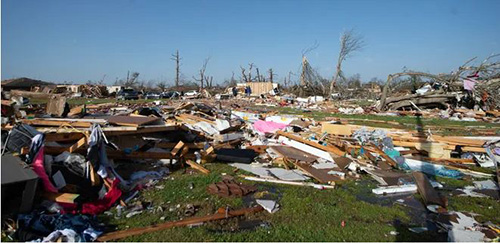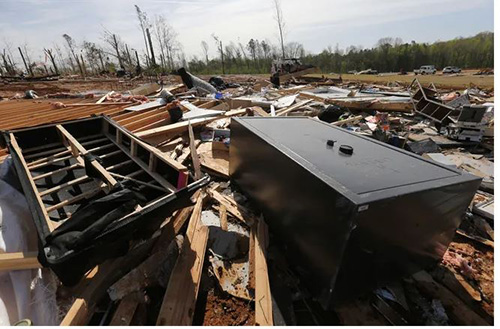NGI's Co-director Dyer Offers Expertise on Why Mississippi is Seeing More Tornadoes, Hail and Flooding
By Brian Broom

A month after an EF-4 tornado hit Rolling Fork, Miss., the intersection of Locus Street and Robert Morganfield Way is blocked off from traffic, Wednesday, April 26, 2023. Photo by Barbara Gauntt, Clarion Ledger
Blinding rain, hail, tornadoes and periods of bitter cold in Mississippi; if you feel these events are happening more often, well, you're right. Mississippi's wild weather is just getting wilder.
So, why is this happening? It boils down to a changing climate.
"First, with climate change and some local issues, we've got a stronger jet stream, said Jaimie Dyer, Mississippi State University professor of meteorology and climatology.
"You get stronger cold fronts coming down and they cause stronger storms. So, we're getting more of these extremes."
Dyer said rising global temperatures are actually moving the jet stream farther north, but at the same time it's causing a wave that dips down into the Southeast more frequently in the spring and fall months. Those changes are affecting our weather patterns.
"During the warmer months the jet stream is moving farther north, which leaves the southeast U.S. with more tropical conditions, including higher temperatures and humidity levels," Dyer said. "This then leads to more energy available for scattered thunderstorms, we call them airmass thunderstorms, which is what we've been seeing the past few days."
And some of that energy produces tornadoes such as those that swept through Mississippi last month.
Mississippi tornadoes between 1950 and 2022

According to Mississippi State University researchers, strong storms capable of producing tornadoes are becoming more common due to climate change. Photo by Hannah Mattix, Clarion Ledger
- Between 1950 and 1970, there wasn't a year with 50 or more tornadoes reported and in six years fewer than 10 were reported.
- Between 2002 and 2022, there were more than 50 tornadoes reported during 16 years.
- Between 2002 and 2022, there were more than 100 tornadoes reported during six years.
- Between 2019 and 2022, there were three years with more than 100 tornadoes reported including the record 181 in 2022.

What was once Blue Front Apartments in Rolling Fork, Miss., lies decimated, Saturday, March 25, 2023, after a tornado ripped through the Delta town. Photo by Barbara Gauntt, Clarion Ledger
A couple of items that go with that are heavier rains and increased risk of hail.
Increased flooding and hail in Mississippi
Dyer said measuring the frequency of hail events isn't an exact science. He explained it can be difficult to detect on radar at times. However, with more strong storms capable of producing hail such as one that pelted parts of Copiah County with hail larger than golf balls last month, it just makes sense it's happening more frequently.
"From my perspective, if we're getting more extreme storms then we're getting more hail," Dyer said.
Rain is also becoming more of an issue. Dyer said it's not that Mississippi is seeing higher annual rainfall totals, it's how we receive it.
Dyer said Mississippi is seeing fewer rains, but when it rains, it pours and causes flooding, overwhelmed storm drain systems and increased river and agricultural land erosion.
"We're getting less frequent events, but when we get it, we get it harder," Dyer said.
Climate change and bitter cold in Mississippi?
When you hear about climate change, topics of discussion usually include things like rising seas, melting ice and higher temperatures. Icy Arctic blasts aren't typically a part of the discussion.

A gun vault and broken debris is all that is left of the home of Chad Mills along Hwy 15 on Saturday, April 1, 2023, in Pontotoc, Miss. Storms that dropped possibly dozens of tornadoes killed multiple people in small towns and big cities across the South and Midwest. Photo by Thomas Wells, AP
Earlier this year, a cold front brought temperatures down into the teens three nights in a row for parts of Mississippi.
In March, a late freeze plunged temperatures into the lower 20s, killing native foliage and damaging crops such as blueberries.
With an energetic jet stream dipping into the South more frequently, events like those could become a part of the landscape.
"Those cold spells are potentially going to be common in the South," Dyer said.
- ASSURE's STEM Outreach Program Takes Center Stage as a Teaching Tool, Earns National Award
- MSU Cross Collaborative Research Teams, Toyota Mississippi and Liquid Wire Inc. Partner on Effort to Improve Industrial Safety Through Wearable Technology
- MSU CAVS Summit Drives Future of Autonomous Ground Vehicles
- MSU's CCI and CSE Continue Support of Federal Cyber Workforce with $4.1 million in New NSF CyberCorps Funding
- MSU's CCS Researcher, Luan, Equates NSF Funding into Environmental, Biological Systems Solutions
- MSU-Developed Land Conservation Tool Recognized by U.S. Fish and Wildlife Service
- Navicky Named Director of MSU High Performance Computing Collaboratory
- MSU Breaks Ground on New High Performance Computing Data Center
- ISER's Duett Inducted into ERDC's Waterways Experiment Station Gallery of Distinguished Civilian Employees
- Improving AI/ML Image Processing to Tackle Bottlenecks of Fisheries Data
- NGI Deputy and Associate Directors, Sims and Dyer, Advise Researchers in Studying Climate Change to Improve Resilience to Natural Disasters
- MSU's NGI Climate and Math Experts Calculate Statistically Sound Data on Declining Snow Cover
- NGI and NOAA Partners at 2023 GOMA All Hands Meeting
- 2023 Hypoxia Monitoring Results Featured in Press Releases and Media Event
- NOAA and NGI Scientists Publish a New River Chemistry and Discharge Dataset for U.S. Rivers
- MSU's Burch Moves to ORED as Associate Vice President
- Pricope Joins MSU as Associate Vice President for Research

